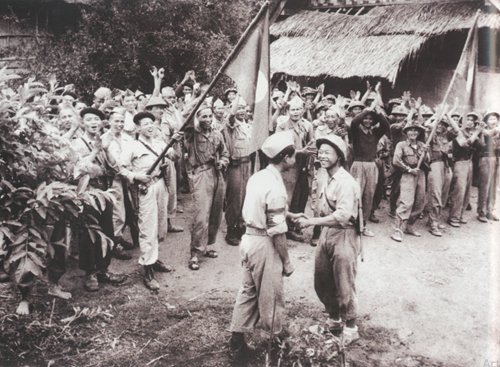These volunteer units engaged in "three together" activities with local villagers, disseminated information, mobilized people to participate in the national resistance, and built political bases and local armed forces. Through their efforts, the credibility of the revolutionary forces was enhanced, and an increasing number of Lao people from various ethnic groups actively participated in the national resistance. This helped strengthen the revolutionary armed forces of Laos in terms of both quantity and quality.
    |
 |
|
Meeting between Vietnamese volunteer soldiers and the Pathet Lao troops during the Upper Laos Campaign in 1953 |
Thanks to the support of the Lao people and Vietnamese volunteer units, the Lao Itxala troops were able to organize ambushes, raids, and destroyed many of the enemy's sweeping and occupying campaigns. They also established and maintained resistance bases throughout Upper, Middle, and Lower Laos. This contributed to creating new momentum and strength for the Lao revolution while developing the Laos-Vietnam combat alliance in the fight against the common enemy.
In the face of new tactics of the enemy, and following the policy of strengthening the Laos-Vietnam combat alliance of the Central Committee of the Workers' Party of Vietnam, the Lao Resistance Government and the Government of Democratic Republic of Vietnam decided to coordinate and launch the Upper Laos Campaign in early February 1953. This campaign was based on the deployment and use of forces in smoothly coordination with enemy pursuit operations on various fronts. Local troops and guerrilla forces in Laos coordinated with Vietnamese volunteer units to intensify the destruction of the enemy and achieved a resounding victory.
With the victory of the 1953 Upper Laos Campaign, the resistance base and rear of the Lao revolution were connected to the free area of Vietnam. This created strategic coordination between Vietnam and Laos, pushing the resistance of the three Indochinese countries forward to a new level and contributing to changing the battlefield situation in Upper Laos.
Participating in the planning, preparation, and fighting of the Upper Laos Campaign, Vietnamese volunteer units were trained and matured, and they learned from experience to better accomplish future missions. The unity of the Vietnamese-Lao alliance in combat became a symbol of encouragement for the people of both countries to continue their struggle for independence, freedom, and national reunification.
By Senior Colonel VONGXAY INTHAKHAM, Lao Defense Attché to Vietnam
Translated by Trung Thanh